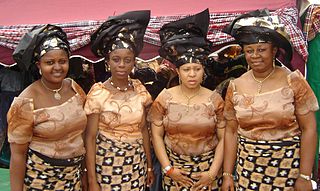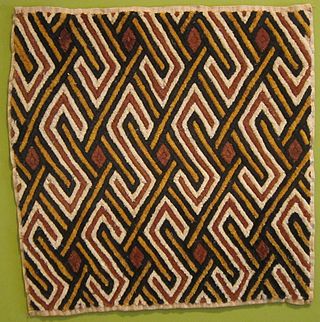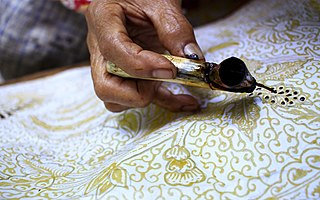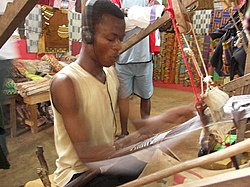
Embroidery is the art of decorating fabric or other materials using a needle to stitch thread or yarn. Embroidery may also incorporate other materials such as pearls, beads, quills, and sequins. In modern days, embroidery is usually seen on hats, clothing, blankets, and handbags. Embroidery is available in a wide variety of thread or yarn colour. It is often used to personalize gifts or clothing items.

Textile arts are arts and crafts that use plant, animal, or synthetic fibers to construct practical or decorative objects.

Batik is a dyeing technique using wax resist. The term is also used to describe patterned textiles created with that technique. Batik is made by drawing or stamping wax on a cloth to prevent colour absorption during the dyeing process. This creates a patterned negative when the wax is removed from the dyed cloth. Artisans may create intricate coloured patterns with multiple cycles of wax application and dyeing. Patterns and motifs vary widely even within countries. Some pattern hold symbolic significance and are used only in certain occasions, while others were created to satisfy market demand and fashion trends.

Bògòlanfini or bogolan is a handmade Malian cotton fabric traditionally dyed with fermented mud. It has an important place in traditional Malian culture and has, more recently, become a symbol of Malian cultural identity. The cloth is exported worldwide for use in fashion, fine art and decoration.

Bandhani is a type of tie-dye textile decorated by plucking the cloth with the fingernails into many tiny bindings that form a figurative design. Today, most Bandhani making centers are situated in Gujarat, Rajasthan, Sindh, Punjab region and in Tamil Nadu where it is known as Sungudi. It is known as chunri in Pakistan. Earliest evidence of Bandhani dates back to Indus Valley civilization where dyeing was done as early as 4000 B.C. The earliest example of the most pervasive type of Bandhani dots can be seen in the 6th century paintings depicting the life of Buddha found on the wall of Cave at Ajanta. Bandhani is also known as Bandhej Saree, Bandhni, Piliya, and Chungidi in Tamil and regional dialects. Other tying techniques include Mothra, Ekdali and Shikari depending on the manner in which the cloth is tied. The final products are known with various names including Khombi, Ghar Chola, Patori and Chandrokhani.

The wrapper, lappa, or pagne is a colorful garment widely worn in West Africa by both men and women. It has formal and informal versions and varies from simple draped clothing to fully tailored ensembles. The formality of the wrapper depends on the fabric used to create or design it.

Plain weave is the most basic of three fundamental types of textile weaves. It is strong and hard-wearing, and is used for fashion and furnishing fabrics. Fabrics with a plain weave are generally strong, durable, and have a smooth surface. They are often used for a variety of applications, including clothing, home textiles, and industrial fabrics.

Cloth of gold or gold cloth is a fabric woven with a gold-wrapped or spun weft—referred to as "a spirally spun gold strip". In most cases, the core yarn is silk, wrapped (filé) with a band or strip of high content gold. In rarer instances, fine linen and wool have been used as the core.
The manufacture of textiles is one of the oldest of human technologies. To make textiles, the first requirement is a source of fiber from which a yarn can be made, primarily by spinning. The yarn is processed by knitting or weaving, with color and patterns, which turns it into cloth. The machine used for weaving is the loom. For decoration, the process of coloring yarn or the finished material is dyeing. For more information of the various steps, see textile manufacturing.

African textiles are textiles from various locations across the African continent. Across Africa, there are many distinctive styles, techniques, dyeing methods, and decorative and functional purposes. These textiles hold cultural significance and also have significance as historical documents of African design.

Resist dyeing (resist-dyeing) is a traditional method of dyeing textiles with patterns. Methods are used to "resist" or prevent the dye from reaching all the cloth, thereby creating a pattern and ground. The most common forms use wax, some type of paste made from starch or mud, or a mechanical resist that manipulates the cloth such as tying or stitching. Another form of resist involves using a dye containing a chemical agent that will repel another type of dye printed over the top. The best-known varieties today include tie-dye, batik, and ikat.

Adire (Yoruba) textile is a type of dyed cloth from south west Nigeria traditionally made by Yoruba women, using a variety of resist-dyeing techniques. The word 'Adire' originally derives from the Yoruba words 'adi' which means to tie and 're' meaning to dye. It is a material designed with wax-resist methods that produce patterned designs in dazzling arrays of tints and hues. It is common among the Egba people of Ogun State.

Hmong Textile Art consists of traditional and modern textile arts and crafts produced by the Hmong people. Traditional Hmong textile examples include hand-spun hemp cloth production, basket weaving, batik dyeing, and a unique form of embroidery known as flower cloth or Paj Ntaub in the Hmong language RPA. The most widely recognized modern style of Hmong textile art is a form of embroidery derived from Paj Ntaub known as story cloth.

Leheriya is a traditional style of textile tie dye from Rajasthan, India. Its designs are inspired by the natural wave(leher) patterns formed by the wind blowing across the desert sands of western Rajasthan. The craft is exclusive to Rajasthan, with its main centres being the cities of Jaipur and Jodhpur.
Textile manufacturing is one of the oldest human activities. The oldest known textiles date back to about 5000 B.C. In order to make textiles, the first requirement is a source of fibre from which a yarn can be made, primarily by spinning. The yarn is processed by knitting or weaving to create cloth. The machine used for weaving is the loom. Cloth is finished by what are described as wet process to become fabric. The fabric may be dyed, printed or decorated by embroidering with coloured yarns.

Natural dyes are dyes or colorants derived from plants, invertebrates, or minerals. The majority of natural dyes are vegetable dyes from plant sources—roots, berries, bark, leaves, and wood—and other biological sources such as fungi.

Akwete cloth is a hand woven textile produced in Igboland for which the town of Akwete, also known as Ndoki, both which the cloth was named after in Abia state, Nigeria is famous. Alternative names include "Aruru" meaning "something woven", "Mkpuru Akwete" and "Akwete fabric". This traditional Igbo weaving processes sisal, hemp, raffia, cotton or other fibres into finished products. While the coarse raffia materials are used by masquerades and in the past as headgear for warriors among other uses, the hemp material was used to weave towels, ropes and handbags. The more comfortable and colorful spun cotton is used to weave cloth for everyday wearing. Akwete cloths contain many motifs. Today, women continue to produce Akwete cloth for a wide, global market.

African wax prints, Dutch wax prints or Ankara, are a type of common material for clothing in West Africa. They were introduced to West Africans by Dutch merchants during the 19th century, who took inspiration from native Indonesian batik designs. They began to adapt their designs and colours to suit the tastes of the African market. They are industrially produced colourful cotton cloths with batik-inspired printing. One feature of these materials is the lack of difference in the colour intensity of the front and back sides. The wax fabric can be sorted into categories of quality due to the processes of manufacturing. The term "Ankara" originates from the Hausa name for Accra, the capital of what is now Ghana. Initially used by Nigerian Hausa tradesmen, it was meant to refer to "Accra," which served as a hub for African prints in the 19th century.

Embroidery was an important art in the Islamic world from the beginning of Islam until the Industrial Revolution disrupted traditional ways of life.
Nakunte Diarra was a Malian textile artist known for her bògòlanfini.


















